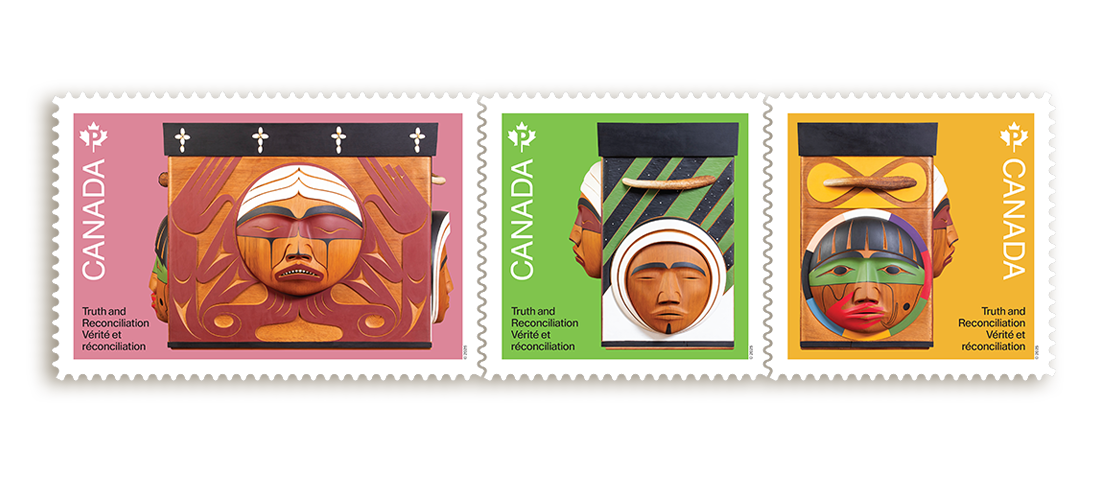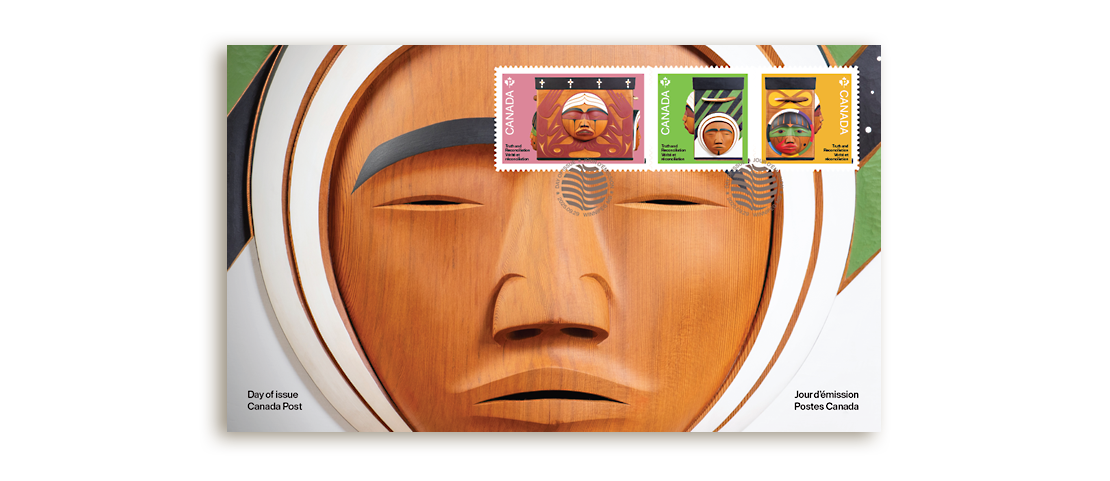To create the stamps, Canada Post again partnered with the Survivors Circle of the National Centre for Truth and Reconciliation (NCTR).
The National Indian Residential School Crisis Line provides 24-hour support to former residential school students and their families. If you require support, please call 1-866-925-4419.
The fourth year of Canada Post’s annual Truth and Reconciliation Stamp series features an image of a sacred and ceremonial Bentwood Box as a tribute to Survivors and a symbol of healing, reconciliation and hope.

Bentwood Box for the Truth and Reconciliation Commission
The Bentwood Box featured on this year’s stamps is the ceremonial box commissioned by Canada’s Truth and Reconciliation Commission (TRC) in 2009.
The box travelled with the TRC to eight national events throughout the country, where people placed personal and often sacred items into the box. Photographs, reports, books, drums, knitted baby blankets and beaded regalia were among the thousands of items placed inside. These gestures of truth and reconciliation symbolized participants’ spiritual journey toward healing.
“Bentwood boxes are a really sacred thing to our people,” says Luke Marston, a Coast Salish master carver from the Stz’uminus First Nation on Vancouver Island, who carved the box for the TRC. “I remember at the time when I had finished the box, an elder had said to me, ‘You’ll never understand how important this is to Canada. You could go your whole life and never carve anything else as meaningful as this.’”
Bentwood boxes are traditional artifacts for many Indigenous communities, especially on Canada’s Pacific Coast. Made from bent and carved wood, they were used to hold oil, food, medicine, ceremonial regalia and canoe tackle, and as water buckets, drums and boxes for burials. Bentwood boxes were also used to steam or cook food by filling them with water and adding hot stones from a fire.
A box representing Indigenous Peoples across Canada
The Bentwood Box has symbolic carvings on each side, representing the distinct cultures of the First Nations, Inuit and Métis children who attended residential schools.
- On the front of the box is an elder representing the West Coast. Her black tears and raised hands represent the helplessness parents felt when their children were taken away. The woman’s crooked fingers reflect Marston’s grandmother, who was pushed down the stairs at a residential school. Her broken finger never healed properly.
- On the right side is an Inuk man, acknowledging Inuit experiences at residential schools. The northern lights are seen in the background and represent Inuit ancestors and teachings. Students were separated from this knowledge while at residential schools.
- On the left side is a depiction of the experiences of students from the Prairies and Eastern Canada. The boy’s hair is cut short, symbolizing the removal of children’s culture. A red hand covers the boy’s mouth – a reference to the silencing of their languages. The war paint on the boy’s face depicts an eagle, symbolizing strength. At the top of the panel is an infinity symbol, from the Métis flag, which acknowledges the Métis children who were taken to residential schools.
- On the back of the box is the thunderbird, reflecting the strong voices of all Indigenous Peoples and the truth about Canada’s history of abuse and injustice.
A sacred box to receive gestures of reconciliation
During the TRC’s work, the box travelled across Canada, receiving items and artifacts that reflected the experiences of those affected by Canada’s residential school system. Eugene Arcand, now a member of the Survivors Circle of the NCTR, was one of the Survivors who travelled with the box at the time. He recalls the many gestures of reconciliation put into the box.
“A large percentage of the gestures of reconciliation was in honour of missing children and unmarked graves, and all those children that never made it home,” Arcand says. “A lot of them were maybe the baby clothes or some ornaments that those missing children had before they went to residential school, or something that was acquired after they were there, even though they didn’t make it home, and were put into the bentwood box. They were very highly charged emotional experiences.”
A powerful reminder to learn about the past and to work toward healing
After being housed temporarily at the Canadian Museum for Human Rights in Winnipeg, Manitoba, the Bentwood Box now resides at the NCTR, in the same city. The Bentwood Box is a powerful reminder for Canadians to confront the past, work toward healing and hold hope for future generations.
Not enough Canadians have embraced the true history about “Canada’s darkest secret,” Arcand says, adding reconciliation cannot happen without the truth being known.
“You know, right in front of all our eyes, wherever we live, off reserve or on reserve, we see the fallout of Indian residential schools. We see the fallout of poverty, addictions, suicides, you name it. All of it comes from the residential school era,” Arcand says. “It’s important that we all learn about it. In my mind, probably not in my lifetime, [but] with the next generations coming up and learning these truths, I think relationships will change.”

Product: Truth and Reconciliation (2025): booklet of 6 Permanent™ domestic rate stamps
Article: 414300111
Stamp Size: total of 3 stamps, 1 Stamp: 45 mm (W) x 30 mm (H), 2 stamps: 30 mm (W) x 30 mm (H)
Quantity: 200,000 booklets of 6 Permanent™ domestic rate stamps (1.2 million stamps)
Printing process: Lithography in 7 colours
Price: $7.44
Product: Truth and Reconciliation (2025): Official First Day Cover
Article: 414300131
Size: 190 mm wide x 112 mm tall
Quantity: 7,000
Cancel: Winnipeg, MB
Price: $4.72
Design: Blair Thomson, Believe in
Printer: Lowe-Martin
Stamps commemorate the Bentwood Box as a symbol of healing and hope for residential school Survivors
Available now